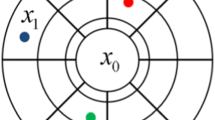Abstract
Stochastic simulation of categorical objects is traditionally achieved either with object-based or pixel-based methods. Whereas object-based modeling provides realistic results but raises data conditioning problems, pixel-based modeling provides exact data conditioning but may lose some features of the simulated objects such as connectivity. We suggest a hybrid dual-scale approach to combine both shape realism and strict data conditioning. The procedure combines the distance transform to a skeleton object representing coarse-scale structures, plus a classical pixel-based random field and threshold representing fine-scale features. This object-distance simulation method (ODSIM) uses a perturbed distance to objects and is particularly appropriate for modeling structures related to faults or fractures such as karsts, late dolomitized rocks, and mineralized veins. We demonstrate this method to simulate dolomite geometry and discuss strategies to apply this method more generally to simulate binary shapes.
Similar content being viewed by others
References
Allard D, Froideveaux R, Biver P (2006) Conditional simulation of multi-type non stationary Markov object models respecting specified proportions. Math Geol 38(8):959–986
Arpat GB, Caers JK (2007) Conditional simulation with patterns. Math Geol 39(2):177–203
Boisvert J, Leuangthong O, Ortiz J, Deutsch CV (2008) A methodology to construct training images for vein-type deposits. Comput Geosci 34(5):491–502
Caers J (2005) Petroleum geostatistics. SPE interdisciplinary primer series. Society of Petroleum Engineers, Richardson
Chilès JP, Delfiner P (1999) Geostatistics: Modeling spatial uncertainty. Series in Probability and Statistics. Wiley, New York
Davies G, Smith LJr (2006) Structurally controlled hydrothermal dolomite reservoir facies: an overview. AAPG Bull 90(11):1641–1690
Deutsch C, Journel A (1998) GSLIB: Geostatistical software library and user’s guide. Oxford University Press, New York
Deutsch CV, Wang L (1996) Hierarchical object-based stochastic modeling of fluvial reservoirs. Math Geol 28(7):857–880
Dubrule O, Kostov C (1986) An interpolation method taking into account inequality constraints: I. Methodology. Math Geol 18(1):33–51
Emery X, Lantuéjoul C (2006) TBSIM: A computer program for conditional simulation of three-dimensional Gaussian random fields via the turning bands method. Comput Geosci 32(10):1615–1628
Favilene O, Cabello P, Arbués P, Munoz JA, Cabrera L (2009) A geostatistical algorithm to reproduce lateral gradual facies transitions. Comput Geosci 35:1642–1651
Freulon X, de Fouquet C (1993) Conditioning a Gaussian model with inequalities. In: Soares A (ed) Geostatistics Tróia ’92, vol 1. Kluwer Academic, Dordrecht, pp 201–212
Geman S, Geman D (1984) Stochastic relaxation, Gibbs distribution and the Bayesian restoration of images. IEEE Trans Pattern Anal Mach Intell 6(6):721–741
Goovaerts P (1997) Geostatistics for natural resources evaluation. Applied geostatistics series. Oxford University Press, New York
Gringarten E (1998) FRACNET: Stochastic simulation of fractures in layered systems. Comput Geosci 24(8):729–736
Haldorsen HH, Damsleth E (1990) Stochastic modeling. J Pet Sci Technol 42:404–412
Henrion V, Pellerin J, Caumon G (2008) A stochastic methodology for 3D cave systems modeling. In: Ortiz J, Emery X (eds) Proceedings of the eight international geostatistics congress, vol 1. Gecamin ltd, Santiago, pp 525–533
Holden L, Hauge R, Skare A, Skorstad A (1998) Modeling of fluvial reservoirs with object models. Math Geol 30(5):473–496
Jones M, Baerentzen J, Sramek M (2006) 3d distance fields: A survey of techniques and applications. IEEE Trans Visual Comput Graphics 12(4):581–599
Journel AG (1994) Modeling uncertainty: Some conceptual thoughts. In: Dimitrakopoulos R et al (eds) Geostatistics for the next century. Kluwer, Dordrecht, pp 30–43
Journel AG (2006) The necessity of multiple-point prior model. Math Geol 38(5):591–610
Labourdette R, Lascu I, Mylroie J, Roth M (2007) Process-like modeling of flank margin caves: From genesis to burial evolution. J Sediment Res 77(10):965–979
Lantuéjoul C (2002) Geostatistical simulation: models and algorithms. Springer, Berlin
Ledez D (2003) Modélisation d’objets naturels par formulation implicite. PhD thesis, INPL, Nancy, France
Renard P, Caers J (2008) Conditioning facies simulations with connectivity data. In: Ortiz J, Emery X (eds) Proceedings of the eight international geostatistics congress, vol 2. Gecamin ltd, Santiago, pp 597–606
Saito T, Toriwaki J (1994) New algorithms for Euclidean distance transformation of an n-dimensional digital picture with applications. Pattern Recognit 27(11):1551–1565
Serra J (1988) Image analysis and mathematical morphology: theoretical advances, vol 2. Academic Press, London
Srivastava R, Frykman P, Jensen M (2004) Geostatistical simulation of fracture networks. In: Leuangthong O, Deutsch C (eds) Proceedings of the seventh international geostatistics congress, vol 1. Springer, Berlin, pp 295–304
Stoyan D, Kendall W, Mecke J (1995) Stochastic geometry and its applications. Wiley, New York
Strebelle S (2002) Conditional simulation of complex geological structures using multiple-point statistics. Math Geol 34(1):1–21
Viseur S (2004) Caractérisation de réservoirs turbiditiques: simulations stochastiques basées-objet de chenaux méandriformes. Bull Soc Géol Fr 175(1):11–20
Yin Y, Wu S, Zhang C, Li S, Yin T (2009) A reservoir skeleton-based multiple point geostatistics method. Sci China Ser D, Earth Sci 52:171–178
Yao T (1998) Conditional spectral simulation with phase identification. Math Geol 30(3):285–308
Author information
Authors and Affiliations
Corresponding author
Rights and permissions
About this article
Cite this article
Henrion, V., Caumon, G. & Cherpeau, N. ODSIM: An Object-Distance Simulation Method for Conditioning Complex Natural Structures. Math Geosci 42, 911–924 (2010). https://doi.org/10.1007/s11004-010-9299-0
Received:
Accepted:
Published:
Issue Date:
DOI: https://doi.org/10.1007/s11004-010-9299-0



